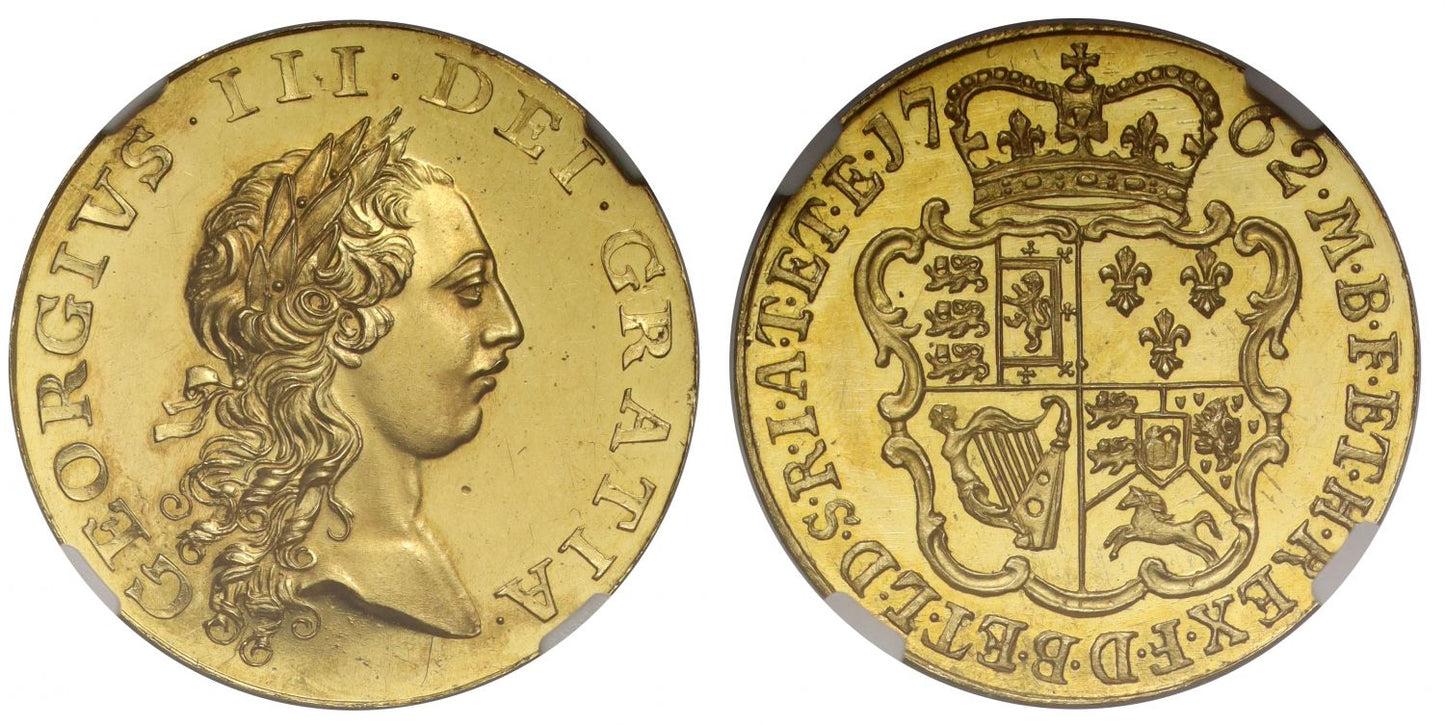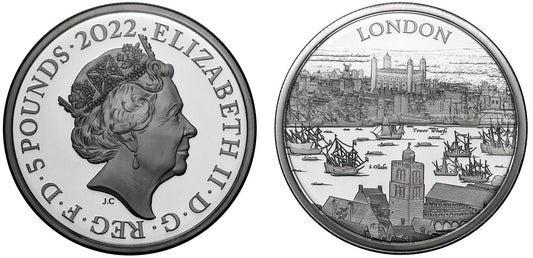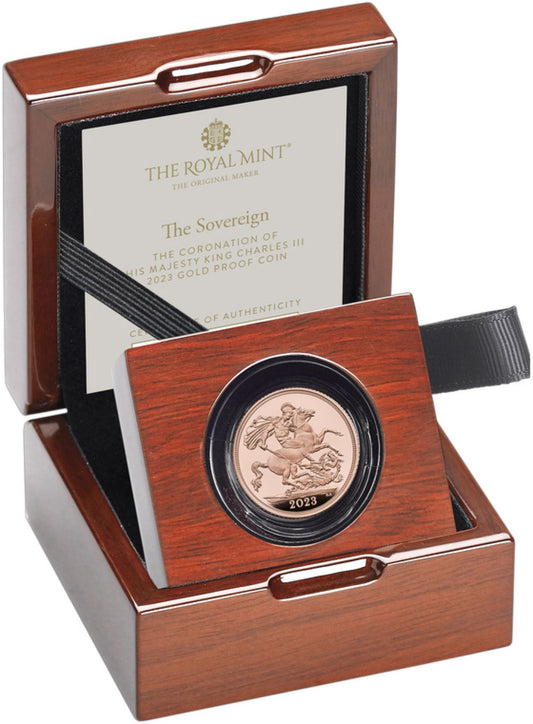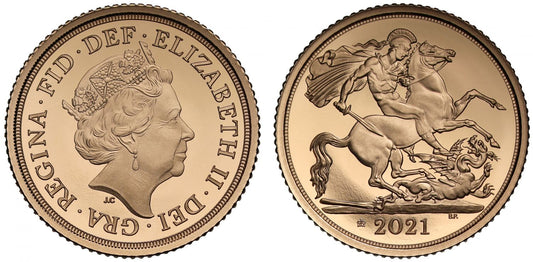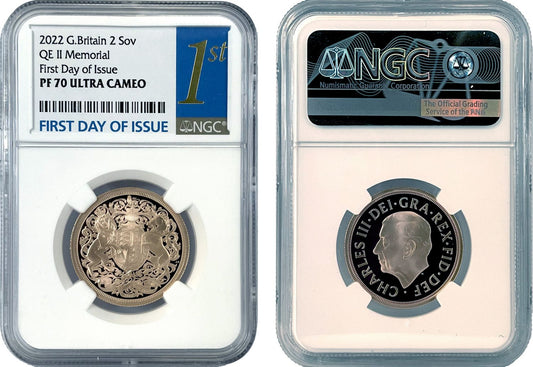FAQs
What makes a coin valuable?
I have coins to sell, what’s the next step?
How will my purchases be shipped?
What happens if I’m not entirely happy with my purchase?
George III 1762 pattern Half-Guinea, NGC PF63+ CAM, provenanced to 1873
George III (1760-1820), gold Pattern Half-Guinea, 1762, engraved by Richard Yeo, first long haired laureate head right, Latin legend and toothed border surrounding, GEORGIVS. III . DEI. GRATIA., rev. struck en medaille, crowned quartered shield of arms, date either side of top crown, Latin legend and toothed border surrounding, M.B.F.ET. H.REX. F.D.B.ET. L.D.S.R.I.AT.ET.E., edge plain (Selig 1147; Montagu 542 this coin; Murdoch 159; Douglas-Morris 82; WR 125 R4; Bull EGC 861 R5; Traveller 2120 this coin; cf.S.3731). Brilliant, with a light tone, just a few hairlines and nicks evident, otherwise as struck, has been slabbed and graded by NGC as PF63+ Cameo with special provenance label, extremely rare.
NGC Certification 2169780-011 - currently the joint finest graded example and with an amazing provenance.
The Latin legends translate to on obverse "George the Third by the Grace of God" continuing on the reverse in abbreviated Latin which if in shown in full reads "Magnae Britanniae Franciae et Hiberniae Rex Fidei Defensor Brun et Lunebergen-sis Dux, Sacri Romani Imperii Archi-Thesaurius et Elector" and translates as "King of Great Britain, France and Ireland, Defender of the Faith, Duke of Brunswick and Luneberg, High Treasurer and Elector of the Holy Roman Empire."
Provenance Story:
This coin has a most intriguing provenance being hidden away in a European family collection since before World War II. The "Traveller" was a wealthy gentleman who having inherited a portion of a successful family company, made a fortune by promptly selling it and then travelled the world on what was in part an extended honeymoon for the decade between the Wall Street Crash of 1929 and the outbreak of World War II. With the financial instability of the great depression and after dabbling at first with gold bullion, he decided to form an enormous collection of world gold coins from ancient to modern whilst travelling the world to see the relevant dealers in their geographical locations to find the most appropriate coins. The result was a collection of some 15,000 coins, 1,700 of which we are told are British, with all going into secure hiding as of 1940 when the nazi regime encroached on where our traveller was located. Sadly, the collector died of a stroke with the stress of the world situation at this time and the collection remained hidden away for decades, stored carefully in individual envelopes in cigar boxes within locked aluminium strongboxes, that were buried in the ground in a field at the collector's property. His wife carried the secret of the burial location for the decades following and reaching the end of her life some 50 years later divulged the secret to her only daughter, whereupon in the 1990s the family retrieved all the coins intact and secured them safely in a bank vault until it was time to sell by auction in 2025. Though we often hear of buried treasure or hoards of coins from antiquity in the ground, it is not often we hear of a sophisticated coin collection actually being buried for decades, an intriguing story to permanently associate with coins of the Traveller provenance which has been written about in newspapers and online worldwide. We are lucky enough to have secured a small number of rare British coins from this esteemed collection.
Ownership of this coin has been traced back through five other esteemed collectors dating back to Victorian times. The Traveller purchased the coin from the Thomas Bryan Clarke-Thornhill (1857-1934) collection, who owned over 10,000 coins of the World in varying metals and worked in the diplomatic service but lived on independent wealth in London joining the British Numismatic Society in 1912. The collection was so significant that when he died the British Museum was given first choice from the collection for potential upgrades and filling of any gaps in the national collection and they selected over 6,000 pieces with the rest then being sold. The auction of 1937 contained 936 lots of British and foreign coins and is always a good mark of quality.
Prior to that collection this rare pattern piece was owned by stamp dealer George Hamilton-Smith who was Managing Director of Stanley Gibbons Ltd from 1922 till his death in 1926 and member of the British Numismatic Society since its inception in 1903. Stanley Gibbons owned a controlling shareholding of the auctioneer Glendining at the time where the collection was then subsequently sold.
This rarity appeared for sale on Spink's Catalogue of the coins of George I to Victoria owned by wealthy London solicitor and numismatic author Hyman Montagu (1845-95) who was divesting himself of this area to concentrate on other coinages. The wonderful catalogue of this collection contains a number of actual photographs of the coins and is one of the earliest partly illustrated coin catalogues of the UK. With his means Montagu was able to pick and choose the collections he wanted and had purchased the collection of Bristol based solicitor William Brice (c.1812-87) in its entirety upon his demise in 1887.
William Brice had purchased this Half-Guinea pattern at the sale of civil servant J. B. Bergne (1800-73) who was one of the founders of the Numismatic Society of London in 1836 and a very significant figure and author of learned articles in British numismatics. Interestingly he offered his entire collection for sale for £3,000 not long before he died but as there were no takers it was sold after he died in 1873 for a total of £6,102/13/-.
Provenance:
Ex John Brodribb Bergne, Sotheby, 20th May 1873, lot 1228, sold for £1/18/-.
Ex William Brice Collection, purchased en bloc by Hyman Montagu in 1887.
Ex "Spink & Sons catalogue of Mr Montagu's Collection of coins from George I to Victoria", October 1890, lot 542
Ex George Hamilton-Smith, Glendining, 23rd May 1927, lot 166, sold for £13/10/-.
Ex T. Bryan Clarke-Thornhill, first portion, Glendining, 25th May 1937, lot 353 sold for £12/10/-.
Ex The Traveller Collection.
FAQs
What makes a coin valuable?
I have coins to sell, what’s the next step?
How will my purchases be shipped?
What happens if I’m not entirely happy with my purchase?
